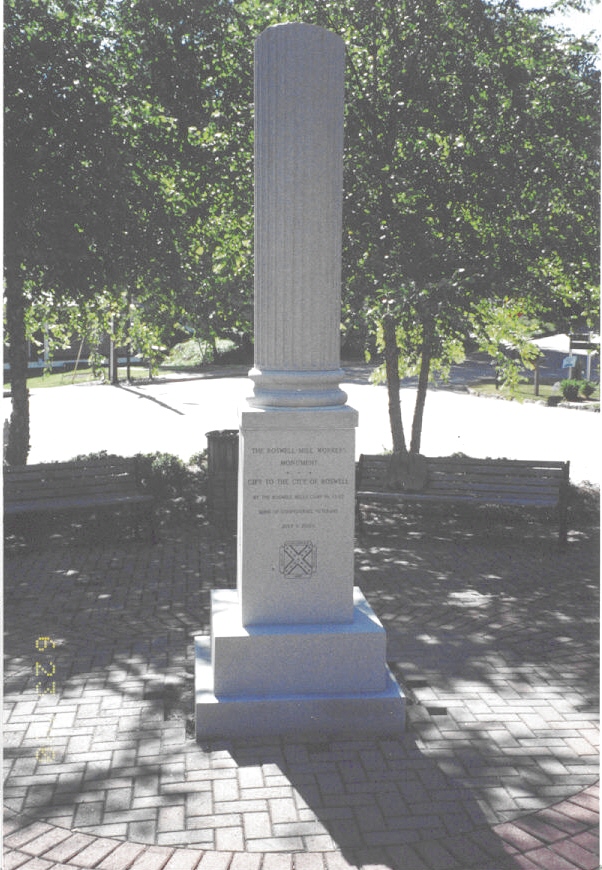|
|
|
THE STORY OF THE ROSWELL MILL WORKERS DEPORTATION

The
Monument of Honor
Old Mill Park,Slaon St. Roswell,GA
Dedicated July,2000
On July 5, 1864,
Federal General Kenner Garrard's cavalry reached Roswell and finding it
undefended, occuiped the city. General Garrard reported to General William
T.Sherman on July 6, 1864 that..." there
were fine factories here.I had the building burnt, all were burnt. The
cotton factory was working up to the time of its destruction, some 400 women
being
employed."
Former Associate Dean
of Emory University, Webb Garrison writes of the destruction of the Roswell
Mills. He says..."incidents of this occurred repeatedly throughout
the Civil War. Had the usual attutides prevailed, the destruction of the
industrial complex would have ended the matter. That it did not was due to the
temperament and inclination of the man (Sherman)."
When General
Sherman did next would shock good people in the North and create a mystery that
has endured to this day. On July 7,1864, Sherman reported to his superiors
in Washington... "I have ordered General Garrard to arrest for treason all
owners and employees, foreign and native (of the Roswell Mills), and send them
under guard to Marietta, whence I will send them North."
On July 7, 1864,
Sherman wrote to General Garrard..."I repeat my orders that you arrest all
people, male and female, connected with those factories, no matter the clamor,
and let them foot it, under guard to Marietta, then I will send them by cars to
the North."
A northern newspaper correspondent reported on the deportation... " only think of it! Four hundred weeping and terrified Ellen's, Susan's, and Maggies transported in springless and seatless army wagons, away from their loved ones and brothers of the sunny South, and all for the offense of weaving tentcloth."
On
July 10,1864 General Thomas reported the arrival of four to five hundred mill
hands, mostly women, in Marietta. Other documents indicate that an
undetermined number of children accompanied their mothers. Webb Garrison
writes of the women's arrival in Marietta..." for the military record that
closed the case in which women and children were illegally deported after having
been charged with treason." He further writes... " had the Roswell
incident not been followed immediately by major military developments, it might
have made a lasting impact upon opinion. In this century, few analysts
have given it emphasis it deserves."
In
conclusion Dr. Garrison writes..." The mystery of the Roswell women, whose
ultimate fate remains unknown, is one of major importance in its own right.
Even more significant is its foreshadowing of things to come."
The mystery of the Roswell women is made up of four to five hundred tragedies. Most of these stories are lost to history; however, three men invloved in the monument are either related to or desended from the mill workers. Wayne Bagley of the Roswell Mills Camp of the Sons of Confederate Veterans is related to Adeline Bagley Buice. Adeline was a seamstress working at the Roswell Mills while her husband was off to war. Deported north with the other women, she went all the way to Chicago. Left to fend for herself as best she could, it would be five years before Adeline and her daughter would return to Roswell on foot . In time, thinking her dead, he remarried. Adeline's grave, in Forsyth County is maintained with a special marker by the Sons of Confederate Veterans.
George Kendley, also a member of the Roswell Mills Camp, is descended from John R. Kendley who served early as a Sergant in Company H, known as the "Roswell Guards", 7th Regiment, GVI, Army of Northern Virginia. He was captured, paroled, and returned to work in the mill. Johnlater served as a Lieutenant in Company A, Roswell Battalion. Because he was paroled, he had to leave early when Union troops got close. If captured, he would have been shot on the spot.
Wayne
Shelly is a member of the Nathan Bedford Forrest Camp of the Sons of Confederate
Veterans in Rome, Georgia. His grandmother was a teenage mill
worker and her mother and her grandmother also worked at Roswell
Mills. All three were charged with treason and dpeorted. The mother
died on a train between Chattanooga and Nashville, Tennessee. The
grandmother died on steamship on the Ohio River, after being carried aboard in a
rocking chair. Wayne's grandmother married a Confederate Veteran in
Louisville, Kentucky. The two tried to make a new life in Indiana;
however, the deportation had ruined the health of the young mill worker and a
doctor advised that she she would not live through another Indiana winter.
The couple moved south to Cartersville,Georgia.
The War Between the States was without question Roswell's moment on the stage of world history. If Roswell has a history, it is surely in the part the mill workers story.
Excerpt from the Dedication
Program for the Mill Workers Monument
July 8, 2000
Confederate Units from Roswell
The Roswell Battalion
Local Defense Troops
Company E, Cobb's Legion Cavalry Battalion
"Roswell Troopers"
Company H, 7th Georgia Volunteer
Infantry
"Roswell Guards"